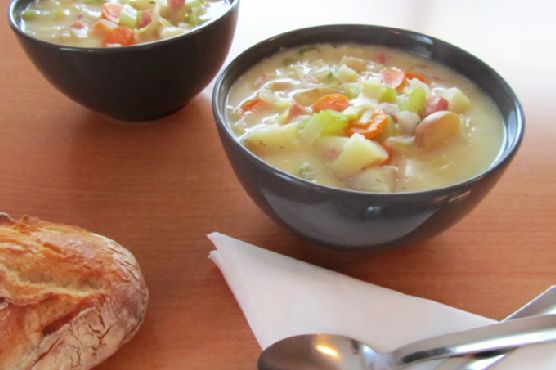Tampa Cuban Sandwich
Tampa Cuban Sandwich is a main course that serves 1. One portion of this dish contains about 558g of protein, 120g of fat, and a total of 3666 calories. For $23.95 per serving, this recipe covers 75% of your daily requirements of vitamins and minerals. This recipe from Foodnetwork requires oregano, lime juice, orange juice, and garlic. A few people made this recipe, and 15 would say it hit the spot. From preparation to the plate, this recipe takes approximately 3 hours and 5 minutes. Taking all factors into account, this recipe earns a spoonacular score of 90%, which is awesome. Grilled Cuban Sandwich (Sandwich Cubano), Cuban Sandwich, and Cuban Sandwich are very similar to this recipe.
Servings: 1
Preparation duration: 30 minutes
Cooking duration: 155 minutes
Ingredients:
4 bay leaves
5 pounds boneless pork shoulder
1 9-inch piece Cuban bread
8 large cloves garlic
4 thin slices glazed ham (about 4 ounces)
Kosher salt and freshly ground pepper
1/2 cup fresh lime juice
1/2 cup fresh orange juice
2 teaspoons dried oregano
2 pickle slices
3 to 4 thin slices Genoa salami with peppercorns (about 1 ounce)
2 thin slices Swiss cheese (about 1 ounce)
Unsalted butter, softened, for cooking
1 tablespoon yellow mustard
Equipment:
panini press
frying pan
roasting pan
knife
measuring cup
food processor
kitchen thermometer
oven
Cooking instruction summary:
Prepare the pork: Cut small slits all over the meat with a knife and put skin-side down in a roasting pan. Mix the lime juice and orange juice in a measuring cup. Transfer 1/4 cup juice mixture to a food processor; add the garlic, oregano, 1/2 teaspoon salt and 1/4 teaspoon pepper and pulse to make a paste. Rub over the pork and into the slits. Pour the remaining 3/4 cup juice over the pork; press the bay leaves on top. Cover and refrigerate 3 to 6 hours. Preheat the oven to 350 degrees F. Turn the pork skin-side up and roast until a thermometer inserted into the middle registers 160 degrees F, about 2 hours, 30 minutes. Cool completely before slicing. (Refrigerate leftover pork in an airtight container up to 1 week.) Make the sandwich: Cut the bread in half lengthwise. Layer the ham, 3 thin slices roast pork, the salami, cheese and pickles on the bottom half. Spread the mustard on the inside of the top half. Heat a nonstick skillet over medium heat. Butter the outside of the sandwich, then add to the pan and put a heavy skillet on top to weigh it down; cook until golden, 3 to 4 minutes per side (or cook in a sandwich press). Cut in half on the diagonal. In any Cuban sandwich, mojo-marinated pork is key. Look for bottled marinade in Latin markets, or try this recipe from Tampa's legendary Columbia Restaurant. Photograph by Steve Giralt
Step by step:
Make the sandwich
1. Cut the bread in half lengthwise. Layer the ham, 3 thin slices roast pork, the salami, cheese and pickles on the bottom half.
2. Spread the mustard on the inside of the top half.
3. Heat a nonstick skillet over medium heat. Butter the outside of the sandwich, then add to the pan and put a heavy skillet on top to weigh it down; cook until golden, 3 to 4 minutes per side (or cook in a sandwich press).
4. Cut in half on the diagonal.
5. In any Cuban sandwich, mojo-marinated pork is key. Look for bottled marinade in Latin markets, or try this recipe from Tampa's legendary Columbia Restaurant.
6. Photograph by Steve Giralt
Prepare the pork
1. Cut small slits all over the meat with a knife and put skin-side down in a roasting pan.
2. Mix the lime juice and orange juice in a measuring cup.
3. Transfer 1/4 cup juice mixture to a food processor; add the garlic, oregano, 1/2 teaspoon salt and 1/4 teaspoon pepper and pulse to make a paste. Rub over the pork and into the slits.
4. Pour the remaining 3/4 cup juice over the pork; press the bay leaves on top. Cover and refrigerate 3 to 6 hours.
5. Preheat the oven to 350 degrees F. Turn the pork skin-side up and roast until a thermometer inserted into the middle registers 160 degrees F, about 2 hours, 30 minutes. Cool completely before slicing. (Refrigerate leftover pork in an airtight container up to 1 week.)
Nutrition Information:
covered percent of daily need















